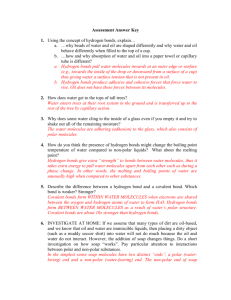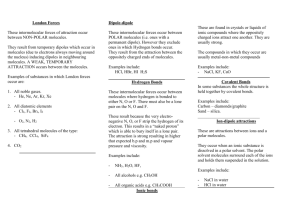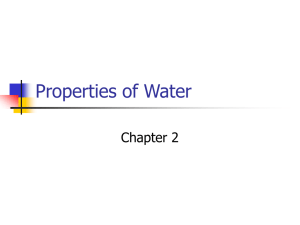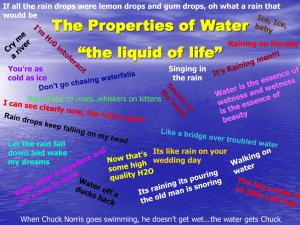NOTE: Molecules that can form hydrogen bonds with themselves
advertisement
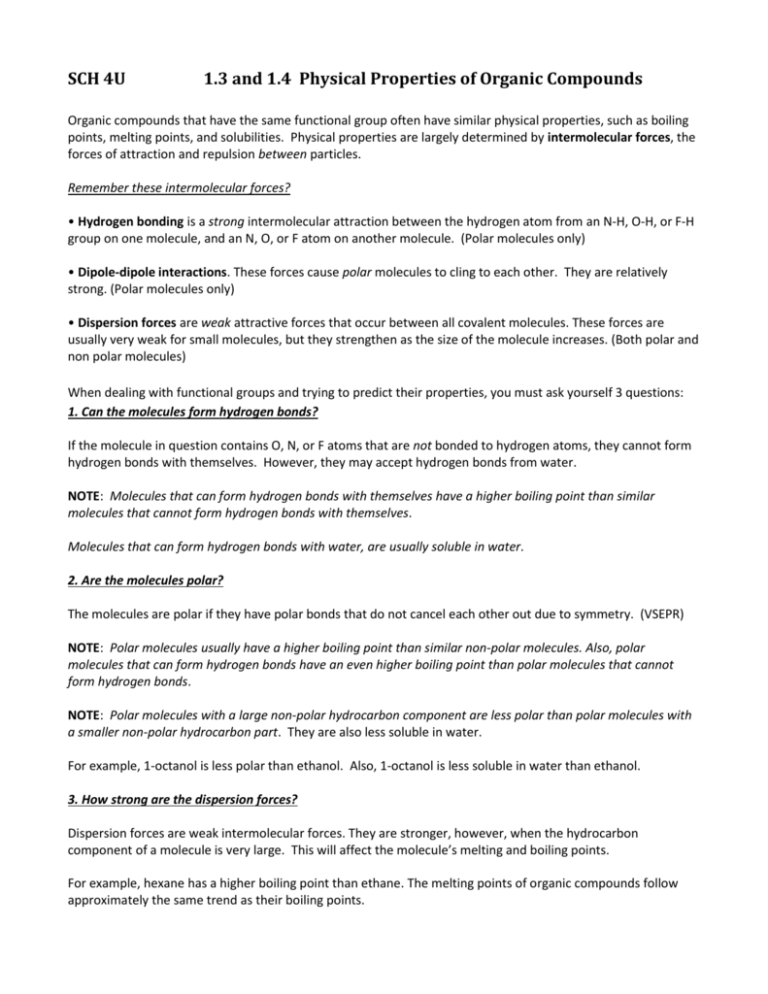
SCH 4U 1.3 and 1.4 Physical Properties of Organic Compounds Organic compounds that have the same functional group often have similar physical properties, such as boiling points, melting points, and solubilities. Physical properties are largely determined by intermolecular forces, the forces of attraction and repulsion between particles. Remember these intermolecular forces? • Hydrogen bonding is a strong intermolecular attraction between the hydrogen atom from an N-H, O-H, or F-H group on one molecule, and an N, O, or F atom on another molecule. (Polar molecules only) • Dipole-dipole interactions. These forces cause polar molecules to cling to each other. They are relatively strong. (Polar molecules only) • Dispersion forces are weak attractive forces that occur between all covalent molecules. These forces are usually very weak for small molecules, but they strengthen as the size of the molecule increases. (Both polar and non polar molecules) When dealing with functional groups and trying to predict their properties, you must ask yourself 3 questions: 1. Can the molecules form hydrogen bonds? If the molecule in question contains O, N, or F atoms that are not bonded to hydrogen atoms, they cannot form hydrogen bonds with themselves. However, they may accept hydrogen bonds from water. NOTE: Molecules that can form hydrogen bonds with themselves have a higher boiling point than similar molecules that cannot form hydrogen bonds with themselves. Molecules that can form hydrogen bonds with water, are usually soluble in water. 2. Are the molecules polar? The molecules are polar if they have polar bonds that do not cancel each other out due to symmetry. (VSEPR) NOTE: Polar molecules usually have a higher boiling point than similar non-polar molecules. Also, polar molecules that can form hydrogen bonds have an even higher boiling point than polar molecules that cannot form hydrogen bonds. NOTE: Polar molecules with a large non-polar hydrocarbon component are less polar than polar molecules with a smaller non-polar hydrocarbon part. They are also less soluble in water. For example, 1-octanol is less polar than ethanol. Also, 1-octanol is less soluble in water than ethanol. 3. How strong are the dispersion forces? Dispersion forces are weak intermolecular forces. They are stronger, however, when the hydrocarbon component of a molecule is very large. This will affect the molecule’s melting and boiling points. For example, hexane has a higher boiling point than ethane. The melting points of organic compounds follow approximately the same trend as their boiling points. Organic Compounds listed in order of increasing solubility in water AND melting/boiling points: 1o Amide 2o and 3o Amides Carboxylic Acids Amines Alcohols Alkyl Halides Ester Aldehydes and Ketones Ether Hydrocarbons Because primary amides have two NH bonds, they have even stronger hydrogen bonds than carboxylic acids. The CN and NH bonds are polar. Secondary amides also experience hydrogen bonding. Their solubility decreases as the non-polar hydrocarbon part of the molecule increases in size. The OH and CO bonds make carboxylic acids polar. Hydrogen bonding occurs between carboxylic acid molecules as well as water molecules. The solubility of carboxylic acids in water decreases as the number of carbon atoms increases. CN and NH bonds are polar. The presence of one or more NH bonds allows hydrogen bonding to take place. The solubility of an amine decreases as the number of carbon atoms increases. The boiling points of primary and secondary amines (which contain NH bonds) are higher than the boiling points of tertiary amines (which do not contain an NH bond). The OH bond is very polar. Alcohols experience hydrogen bonding with other alcohol molecules and with water. The solubility of an alcohol decreases as the number of carbon atoms increases. Alkyl halides are similar in structure, polarity, and reactivity to alcohols. Esters are polar. They contain a CO bond. Therefore, esters can accept hydrogen bonds from water but not from other ester molecules. The CO bond is polar, so aldehydes and ketones are polar. They can accept hydrogen bonds from water but not from other aldehyde or ketone molecules. The CO bond makes ethers polar. Hydrogen bonding cannot occur between ether molecules but can occur between an ether molecule and water. Hydrocarbons – non polar – the longer they are, the more dispersion forces they have, and the higher the melting/boiling point. But they are NOT soluble in water. Examples: 1. Which of the following compounds are soluble in water? Which one has the highest melting/boiling point? (a) propane (b) heptanes (c) 1-propanol (d) 1-heptanol 2. Does ethanol or methoxymethane have a higher melting/boiling point? 3. Which is more soluble in water? 1-octanol or ethanol? 4. Arrange the following molecules in order of increasing melting/boiling point: propane, 1-propanol, propanal, propanoic acid 5. Which of the following compounds is considered to be non-polar? (a) CH3CH2OH (b) CH3CHO 6. (d) CH3CH2NH2 (e) CH3CH2CH3 Identify the compound that is likely to have the highest boiling point. (a) CH4 7. (c) CH3COOH (b) CH3OH (c) CH3CH3 (d) CH3CH2CH2CH2OH (e) CH3CH2CH2CH2CH3 Which of the following compounds is unable to form hydrogen bonds with itself? (a) CH3CH2CH2CH2OH (b) CH3CH2NH2 (c) CH3COOH (d) CH3CH2CH2COOCH2CH3 (e) CH3CH2CONHCH3



